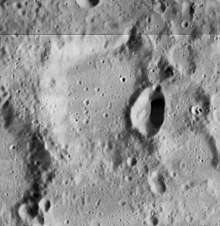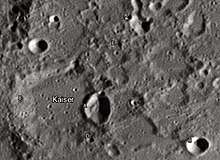Kaiser (lunar crater)
Kaiser is a lunar impact crater. It lies in the crater-riddled terrain in the southern part of the Moon's near side. It was named after the Dutch astronomer Frederik Kaiser.[1] The crater is nearly attached to the northeast rim the slightly larger crater Fernelius, and the two are separated by an irregular patch of ground only a few kilometers wide. To the northwest of Kaiser lies Nonius, a crater remnant.
 Mosaic of Lunar Orbiter 4 images | |
| Coordinates | 36.5°S 6.5°E |
|---|---|
| Diameter | 52 km |
| Depth | 1.8 km |
| Colongitude | 354° at sunrise |
| Eponym | Frederik Kaiser |
The rim of this crater is heavily worn from impact erosion, and the features have been generally softened and rounded. Parts of the southern inner wall has become incised, and the elongated satellite crater Kaiser A lies across the eastern rim. The interior floor of Kaiser is relatively featureless, being marked only by a few tiny craterlets.
Satellite craters

By convention these features are identified on lunar maps by placing the letter on the side of the crater midpoint that is closest to Kaiser.
| Kaiser | Latitude | Longitude | Diameter |
|---|---|---|---|
| A | 36.3° S | 7.3° E | 20 × 14 km |
| B | 36.3° S | 5.6° E | 6 km |
| C | 36.5° S | 9.7° E | 12 km |
| D | 37.0° S | 7.4° E | 5 km |
| E | 34.9° S | 7.1° E | 5 km |
| R | 34.3° S | 7.2° E | 4 km |
References
- "Kaiser (lunar crater)". Gazetteer of Planetary Nomenclature. USGS Astrogeology Research Program.
- Andersson, L. E.; Whitaker, E. A. (1982). NASA Catalogue of Lunar Nomenclature. NASA RP-1097.CS1 maint: ref=harv (link)
- Bussey, B.; Spudis, P. (2004). The Clementine Atlas of the Moon. New York: Cambridge University Press. ISBN 978-0-521-81528-4.CS1 maint: ref=harv (link)
- Cocks, Elijah E.; Cocks, Josiah C. (1995). Who's Who on the Moon: A Biographical Dictionary of Lunar Nomenclature. Tudor Publishers. ISBN 978-0-936389-27-1.CS1 maint: ref=harv (link)
- McDowell, Jonathan (July 15, 2007). "Lunar Nomenclature". Jonathan's Space Report. Retrieved 2007-10-24.CS1 maint: ref=harv (link)
- Menzel, D. H.; Minnaert, M.; Levin, B.; Dollfus, A.; Bell, B. (1971). "Report on Lunar Nomenclature by the Working Group of Commission 17 of the IAU". Space Science Reviews. 12 (2): 136–186. Bibcode:1971SSRv...12..136M. doi:10.1007/BF00171763.CS1 maint: ref=harv (link)
- Moore, Patrick (2001). On the Moon. Sterling Publishing Co. ISBN 978-0-304-35469-6.CS1 maint: ref=harv (link)
- Price, Fred W. (1988). The Moon Observer's Handbook. Cambridge University Press. ISBN 978-0-521-33500-3.CS1 maint: ref=harv (link)
- Rükl, Antonín (1990). Atlas of the Moon. Kalmbach Books. ISBN 978-0-913135-17-4.CS1 maint: ref=harv (link)
- Webb, Rev. T. W. (1962). Celestial Objects for Common Telescopes (6th revised ed.). Dover. ISBN 978-0-486-20917-3.CS1 maint: ref=harv (link)
- Whitaker, Ewen A. (1999). Mapping and Naming the Moon. Cambridge University Press. ISBN 978-0-521-62248-6.CS1 maint: ref=harv (link)
- Wlasuk, Peter T. (2000). Observing the Moon. Springer. ISBN 978-1-85233-193-1.CS1 maint: ref=harv (link)
| Wikimedia Commons has media related to Kaiser (lunar crater). |